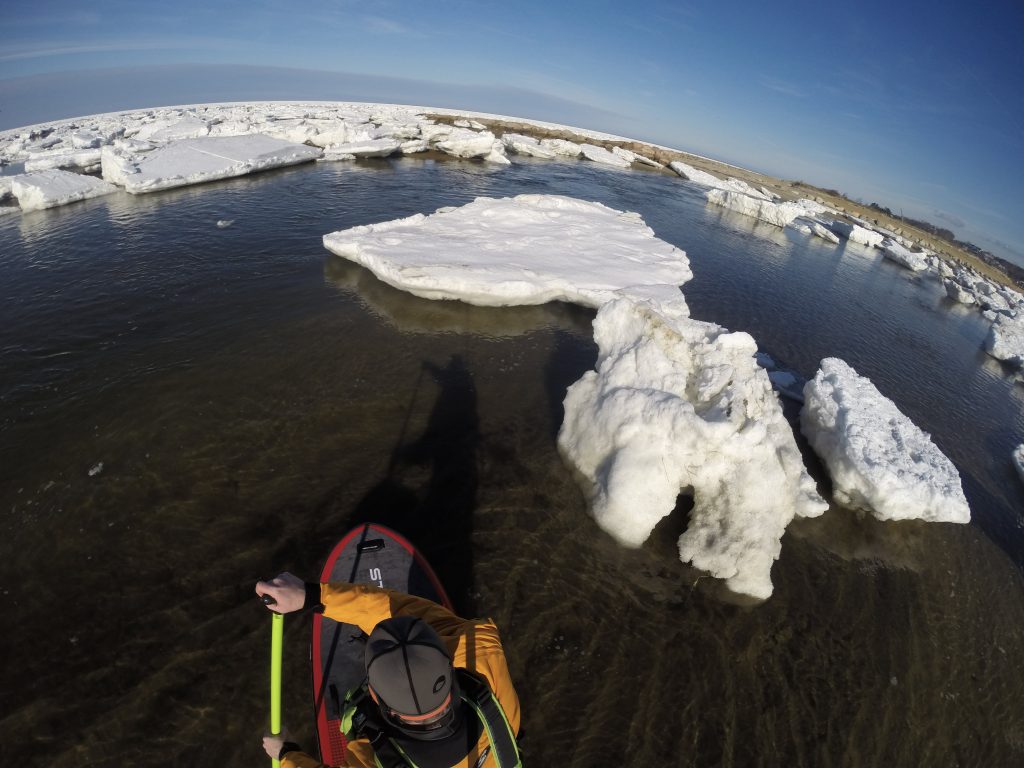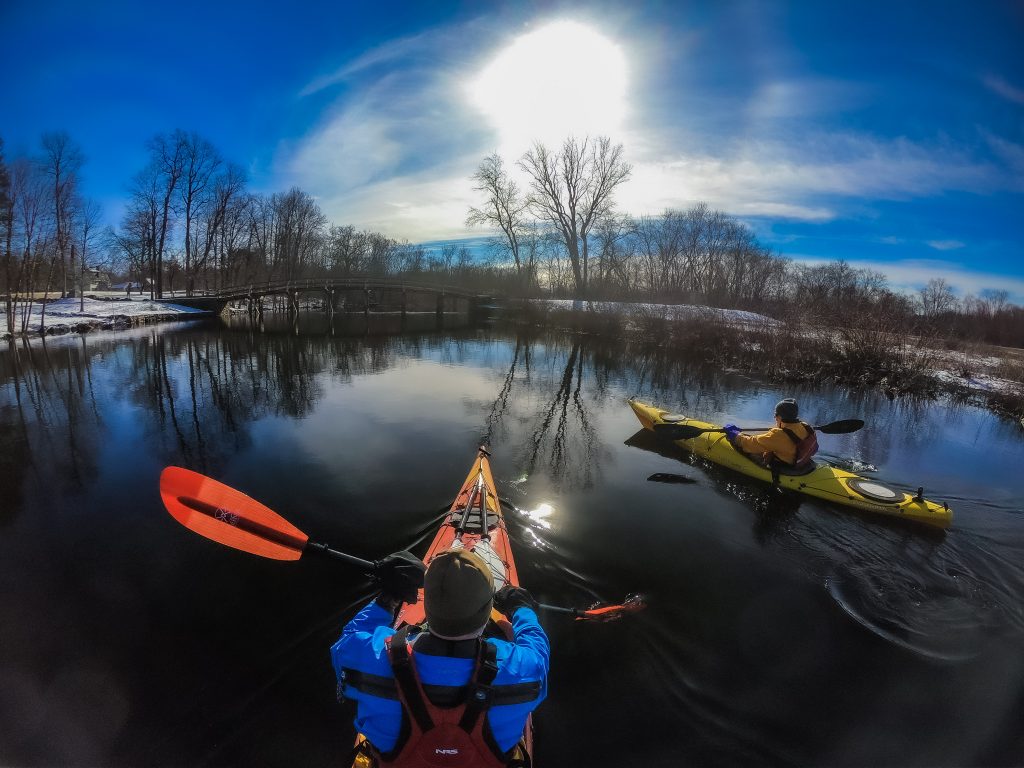Not long ago, the idea of winter paddling was relegated to only the most hardcore and committed paddlers. However, as gear has improved, the number of people hitting the water in winter has grown. Winter is an amazing time to paddle: there are no crowds, no bugs, and the gray, frozen landscape starkly compares to the lush green of spring, blue skies of summer, and multicolored fall foliage. There’s also considerably less margin for error when winter paddling, so take care and keep the following winter paddling tips in mind before getting on the water.

10 Winter Paddling Tips
1. Have a Safety-First Mindset
Safety is at the foundation of every decision you make while winter paddling. Seasoned paddlers are fond of saying we’re all in between swims, which isn’t exactly comforting when the water is frigid and the air even colder. Hypothermia and cold shock (involuntary rapid breathing or hyperventilating caused by sudden immersion in cold water) are two threats constantly lurking that paddlers must protect against.
The best strategy for staying safe is making conservative decisions, staying within your comfort zone, and not capsizing.
2. Wear a Dry Suit
Wearing a dry suit is a must for winter paddlers. A dry suit is a one-piece garment designed to keep you dry and provide invaluable protection in the event you swim. Dry suits are available in configurations with booties and others with gaskets around the ankles. In my experience, dry suits with built-in booties provide two advantages:
- They maintain the consistency of the dry suit’s seal, such that there’s no opening for water to enter.
- Unlike dry suits with latex gaskets at the ankles, they don’t constrict blood flow to the feet (thus keeping your feet warm).
Regardless of what type of dry suit you get, it’s likely to be expensive. But trust me, if you end up in freezing-cold water, you’ll be glad to have invested in a good one.
3. The Right Layers
As their name implies, dry suits keep you from getting wet. What they don’t do is keep you warm, which makes it imperative to layer properly underneath them. Everyone (and every day) is a little different, and layering choices reflect the unique needs of both the paddler and the day. If you’re not sure where to begin, I suggest a two-layer system consisting of:
- A wicking layer: this generally lightweight baselayer is designed to pull moisture from your skin and keep you dry.
- An insulating layer: a midlayer that provides warmth while also helping move moisture away from your body. Heavier-weight base layers and fleece are both popular options for an insulation layer.
Many paddling companies make one-piece insulation layers. While you can certainly repurpose layering pieces from other activities like winter hiking and skiing, paddling-specific one-piece layers are easier to get on and off under a dry suit and prevent gaps and subsequent cold spots. I’m particularly fond of layers with feet, which eliminate the need for liner socks and make it easier to get in and out of my dry suit.
On super cold days, I’ll often add a synthetic-filled jacket under my dry suit for added warmth. Steer clear of down layers which lose their insulative properties when wet. Similarly, avoid the use of any cotton layers, which retain moisture, and will make you colder both in and out of the water.

4. Proper Footwear
Hi-top, wetsuit booties are the way to go for winter paddling. I prefer knee-high, 7mm-thick booties, which help prevent water from pouring in over the top of the cuff at portages and provide extra warmth in winter temperatures.
On super cold days, I add a pair of NRS waterproof socks under my booties and over my dry suit, for an extra level of protection.
5. Warm Hands
I have a range of gloves and mittens to use depending on the conditions. That said, I’ve historically been plagued by cold hands, which is why on most winter adventures I opt for mittens. Mittens have less surface area than gloves—meaning there are fewer places for heat to escape—they also allow your fingers to share warmth. When choosing gloves or mittens for winter paddling, make sure they have sealed seams to keep water out.
Another option for winter paddlers is to employ pogies. If you’re not familiar with pogies, they’re like a mitt that attaches to your paddle rather than your hand. Pogies typically offer a super-warm solution to keeping your hands cozy, the downside is you’ll need to keep another pair of gloves/mitts handy for doing anything that doesn’t involve your paddle—like taking your boat in and out of the water—and if you do swim, you’ll likely need to self-rescue without any hand protection.
6. Protect Your Head
While it’s a myth that we lose most of our body heat through our heads, you’ll still want something to keep your noggin toasty. A wool or fleece hat or balaclava raided from your skiing or winter hiking kit are great options. For particularly cold days, I prefer to carry a paddling-specific neoprene hood, which is designed to keep warmth in and water out.

7. Personal Flotation Device (PFD)
Whether it’s scorching hot summer weather or bitterly cold winter temperatures, I’m a strong believer in wearing a PFD every time I paddle. Wearing a PFD is simply the best thing you can do to keep yourself safe while paddling. According to the U.S. Coast Guard, in 2022 there were 445 drowning deaths of recreational boaters—370 of those victims weren’t wearing a life jacket.
Another reason winter paddlers will want to wear a PFD is that it provides a little extra insulation and protection from the wind.
8. Must-Have Gear
On my PFD I attach a whistle, just in case I need to signal for help. A whistle is louder than I can yell and won’t go hoarse. I also keep my cell phone (in a waterproof case) attached to my PFD. Time matters in cold water and the faster you can call for help, the better—in cold water, the body moves blood from its extremities towards its core, which can cause loss of coordination, strength, and the ability to swim and/or tread water in just three to 30 minutes.
9. Winter Paddleboarding
When winter paddleboarding, I always use a leash to attach the board to my body. This ensures I get my board back and don’t waste valuable energy and time trying to get my board. I attach the leash to my PFD, which keeps my legs free and makes it easy to find if I happen to end up in the water.
10. Winter Kayaking
When winter kayaking, I always carry an extra paddle as a precaution—let’s face it, I’m not swimming my boat back in winter water. I also pack a self-rescue kit, which includes a pump, sponge, tow line, paddle float, and stirrup to aid reentry.

Other Considerations When Winter Paddling
The margin of error while winter paddling is slim and if things go sideways there typically isn’t time to wait for a rescue. Know the weather, tides, and currents before leaving shore. There’s strength in numbers, so avoid paddling alone in the winter. It’s also a smart strategy to leave a float plan with someone onshore detailing where you’re going and when you plan to return.
Remember to paddle well within your ability level—know your limits and stay within them. A rule that has served me well over decades of paddling is when in doubt, don’t go out. Similarly, don’t hesitate to turn around if things don’t feel right or you question the conditions. In the end, winter paddling is about having fun and returning home safely.
Luke Foley
Luke Foley is passionate about discovering and sharing hidden local treasures and has long been a New England adventure enthusiast. After all, there are only a few places where you can skin for fresh tracks in the morning and have a sunset surf session on the same day.
Related Posts
April 2, 2024
10 Tips for Mountain Biking Etiquette During Mud Season
One rough spring could ruin the…




